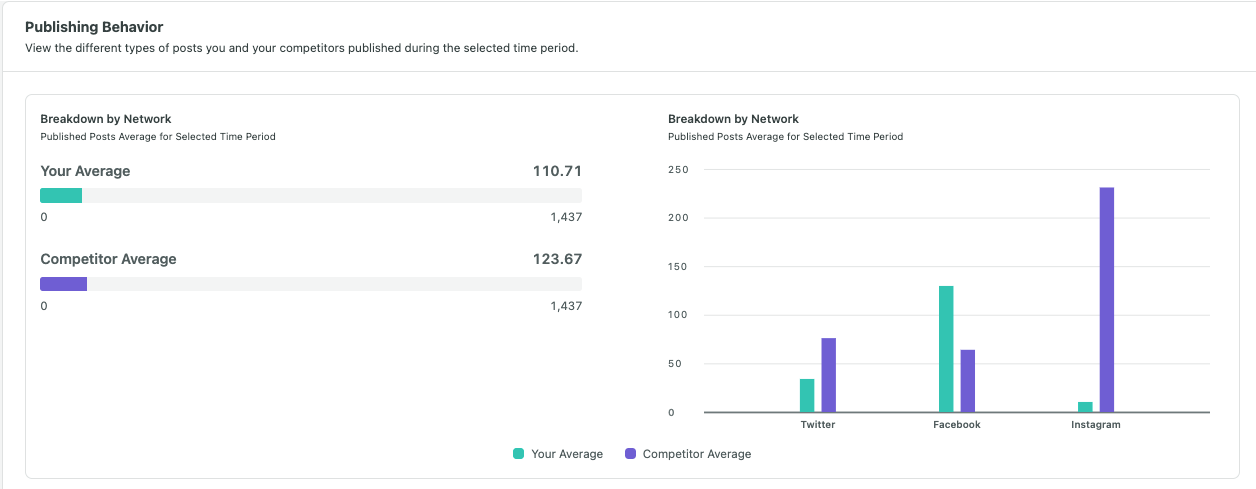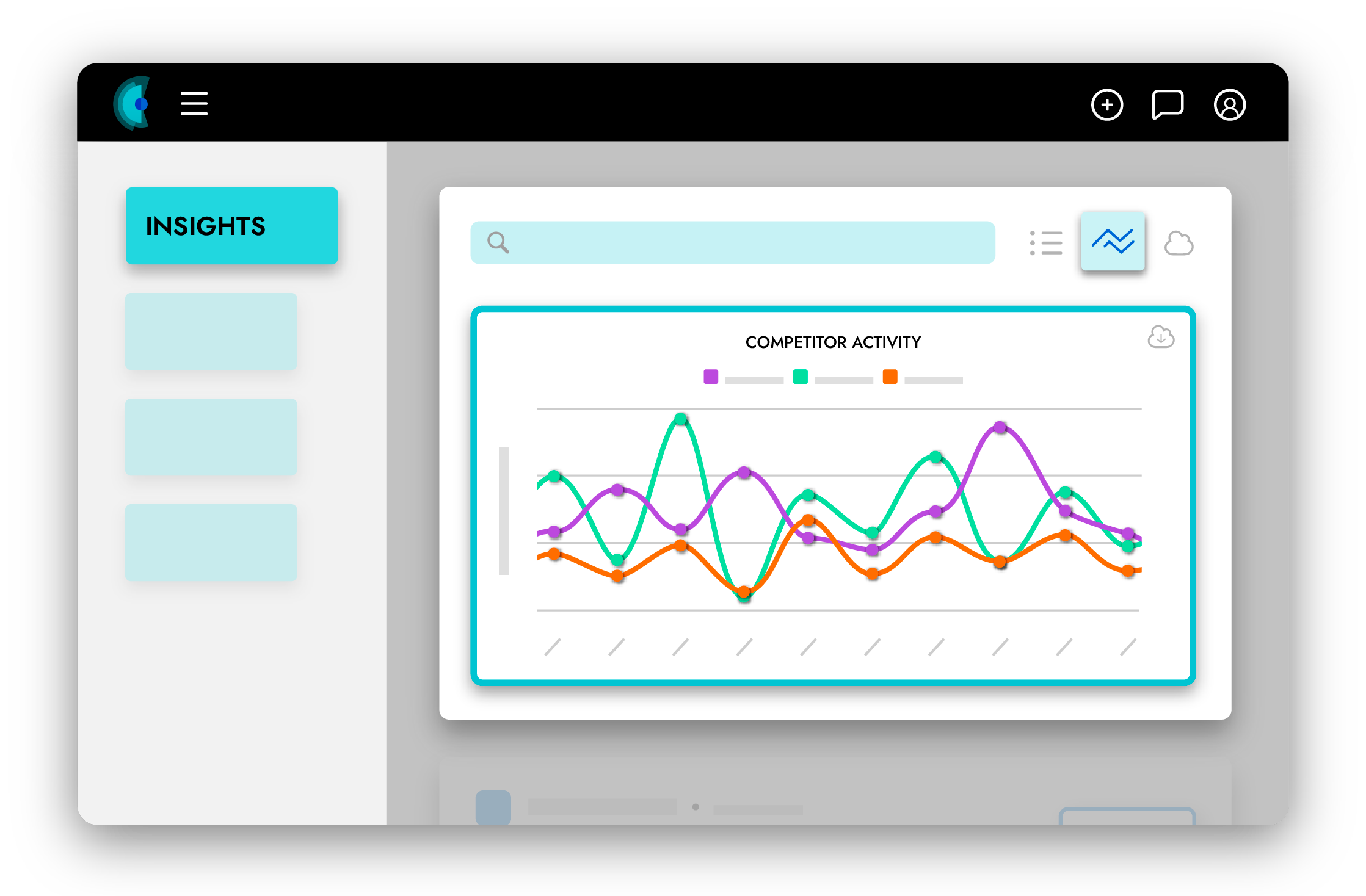Competitive monitoring: tracking the competition to stay ahead

As more companies adopt an omnichannel approach to engage with customers, keeping up with competitors can be challenging.
- What are they posting on social media?
- What’s their email marketing strategy?
- What kind of content are they publishing on their blog?
- Where are they getting most of their traffic from?
You need to know it all.
Competitive monitoring helps you stay on top of this data at all times.
It’s the first step of competitive analysis that involves gathering the intelligence you need to make informed business decisions.
In this article, we’ll walk you through the benefits of competitive monitoring and how to keep an eye on the competition using top strategies, tips and tools.
What is competitive monitoring?
Competitive monitoring is the process of continuously tracking your competitors’ activities and strategies. This includes keeping tabs on your competitors’ social media activity, pricing changes, marketing campaigns, product launches and more.
The goal of competitive monitoring is to understand where (and how) your competitors are outperforming your brand and where there’s an opportunity for you to swoop in.
Competitive monitoring also involves collecting data on market trends and other key aspects of your industry landscape. Businesses can then analyze this data to derive actionable competitive insights and develop long-term strategies to gain competitive advantage.
Why is competitive monitoring important?
Competitive monitoring forms the backbone of competitive intelligence. It deals with collecting insights that help your business stay ahead, adapt and grow.
Here are five key benefits of competitive monitoring:
Get ahead of the competition
The biggest advantage of competitive monitoring is it provides you with the insight you need to gain the upper hand.
By keeping an eye on your competitors’ activities, you can learn from their wins and losses, develop foolproof strategies, better position your products and differentiate your brand.
For example, you might anticipate a new product launch or business merger before it actually happens. This information can help you move quickly to launch a better product or develop strategies to prevent the merger from stealing your brand’s market share.
Identify untapped markets
Tracking competitor weaknesses, shifts in customer demand, market trends and potential threats allows your brand to capitalize on new opportunities before others do.
For instance, you might spot some niche market segments your competitors might be neglecting, like a different age group or interest.
Or, you might find their customers are asking for a new feature. You could add that feature into your product before they do to steal their subscriptions.
Stay on top of industry trends
Things are always changing in business. There might be a new automation software slashing marketing costs in half. Customers might be demanding more eco-friendly products. Or there might be a new viral trend your competitors are all hopping on.
Competitive monitoring helps you stay updated with all the buzz. You’re able to adopt new technologies earlier, align your offerings with customer preferences, pivot your strategies and sidestep missing out on short-term but potentially lucrative marketing trends.
Explore potential gaps in your strategy
Competitive monitoring isn’t just about looking at what others are doing. It’s also about understanding your own strengths and weaknesses.
For example, analyzing your competitor’s social media might reveal gaps in your own strategy. Maybe you need to share more engaging content. Maybe you’re using outdated formats or posting at the wrong times.
Studying your competitors can also highlight weaknesses in your products, services, business model and other areas that could use innovation and improvement.
Set benchmarks for future performance
Monitoring the competition helps you set realistic goals for your business. This could be sales targets, customer satisfaction scores, the number of sign-ups or engagement rates.
For example, you might find your competitor gets consistently get good reviews on Google about their customer service. This could help you set benchmarks for your customer service team so they can try to snag as many or more positive reviews by the end of the quarter.
Or, competitive monitoring could reveal your competitor is ranking on search engines for several high-volume keywords related to your niche. Your goal could be to outrank them by creating quality content around those specific topics.
How to monitor competitors
Competitive monitoring is more than just watching what your competitors are doing. You need to actively collect, analyze and use that data to your advantage.
This means you need a smart, organized strategy combined with the right competitor analysis tools. Here’s a step-by-step guide to monitoring your competition and extracting insights:
Step 1: Identify the top competitors
The first step is to find out who you’re competing with. This may sound simple but it can get messy if you don’t start out in a systematic, organized way.
Before you make a list, divide your competitors into three distinct categories:
- Direct competitors: These are businesses that target the same audience and offer similar products or services to yours (e.g. two accounting software for small businesses.)
- Indirect competitors: These businesses have similar offerings to yours but target a different audience or market segment (e.g. accounting software for small businesses and accounting software for enterprises.)
- Replacement competitors: These businesses offer alternatives to your products or services (e.g. accounting software for small businesses and virtual accounting services.)
Once you’ve got that down, it’s time to do your research.
Find competitors that fall into each category by searching for relevant keywords on Google, scouring social media platforms and forums, using local search on Google Maps and even leveraging market research professionals if you have the budget for it.
Remember to prioritize the competitors that require more attention, such as direct competitors and local businesses operating in your niche.
Step 2: Scope out priorities with SWOT analysis
After identifying your competitors, the next step is to conduct a SWOT analysis for each. This involves breaking down their strengths, weaknesses, opportunities and threats.
Here’s what to look out for:
- Strengths: Start by identifying what your competitors do well. Analyze their product quality, brand reputation, customer service and online presence. For example, if a competitor is known for excellent customer service, note this as a strength.
- Weaknesses: Look for areas where your competitors are lacking. This could be anything from pricing, limited product range to weak engagement. For instance, if a competitor has a poorly designed website, this is a weakness you can capitalize on.
- Opportunities: Identify external factors that could be advantageous for your competitors. This might include market trends, regulatory changes or new technology. For example, if there’s a growing trend for organic products and your competitor offers these, it’s an opportunity for them.
- Threats: Assess external challenges your competitors might face. These could include new market entrants, changing consumer preferences or economic downturns. For instance, if a new competitor enters the market with a disruptive technology, this could be a threat to your existing competitors.

This information can help shape your own strategy. Look for ways to leverage your competitors’ weaknesses and guard against their strengths.
Also, consider how you can position your business, products and services to take advantage of the same opportunities and mitigate similar threats.
Step 3: Benchmark the sources and metrics
Now, it’s time to measure and compare key metrics to understand where your business stands against the competition. Competitor benchmarking can help you set standards and evaluate performance more effectively.
First, determine which metrics are important for your business. These could include social media engagement rates, website traffic, conversion rates or customer satisfaction levels.
With Sprout Social, you can track your competitors’ social media performance on a visual dashboard. Compare metrics like engagement rates, impressions and share of voice across multiple sources, like Facebook, X (formerly Twitter), Instagram and more.

Sprout’s sentiment analysis tool can also provide insights into how customers perceive your competitors. Dig deeper and analyze sentiment in comments, reviews and social media posts to understand how customers think and feel about specific brands—including yours.

Continuously monitor these metrics and compare them with your competitors. Look for trends, spikes or declines in performance to study the impact of recent strategies and campaigns.
Step 4: Plot the timelines for reporting
Finally, establish a reporting schedule for your competitive monitoring efforts. Decide whether you need weekly, monthly or quarterly reports based on your industry’s pace, stakeholder preferences and the intensity of competition.
Your reports should include updates on competitors’ activities, performance benchmarks, and any shifts in consumer sentiment or market trends. This continual flow of information will help you adjust your strategy quickly in response to any changes in the competitive landscape.
Use Sprout’s competitor reports to put together metrics like engagement, follower growth, publishing behavior and top-performing content. Present everything visually with charts, graphs and tables to make sense of the data and identify new opportunities.

Top competitive monitoring tools
You don’t have to track all your competitors manually—thankfully, we have tools for that.
Here are the top three competitive monitoring tools to help you keep an eye on your rivals and make strategic, data-driven decisions for your company.
Sprout Social
Sprout Social is a powerful tool for monitoring competitors on social media platforms like Facebook, Instagram and X (formerly Twitter.)

Benchmark metrics and compare performance with tailored competitor reports. Want to dive deeper? Use Premium Analytics to access more insights with interactive charts and graphs.
Finally, leverage Sprout’s listening tools to monitor public conversations about your competitors and your own brand, understand customer sentiment and identify trends.
Ahrefs
Ahrefs is an SEO competitor monitoring tool that helps you track and understand your competitors’ online performance.

The platform’s site explorer lets you check any URL’s top organic keywords and content. Additionally, Ahrefs can pinpoint the source of your competitors’ backlinks and detail the keywords driving most traffic to their sites.
Crayon
Crayon uses AI to streamline competitor analysis and intelligence. It automatically collects competitor updates and organizes them into a visual dashboard so brands can stay updated.

The tool also supports team collaboration so you can easily share these insights with stakeholders. Additionally, create sales battlecards and newsletters with competitive intelligence to empower your team, and customize dashboards to simplify reporting.
Monitoring competition with Sprout Social
Watching your competitors’ every move can help you in dozens of ways. You can not just outperform them with this intelligence but also identify your own weaknesses, set realistic benchmarks and hop on new trends before they do.
Use Sprout Social to monitor competitors, create engaging, in-depth reports, assess customer sentiment and compare their social media performance metrics with your own. Ready to check it out for yourself? Sign up for a free trial today.

Share